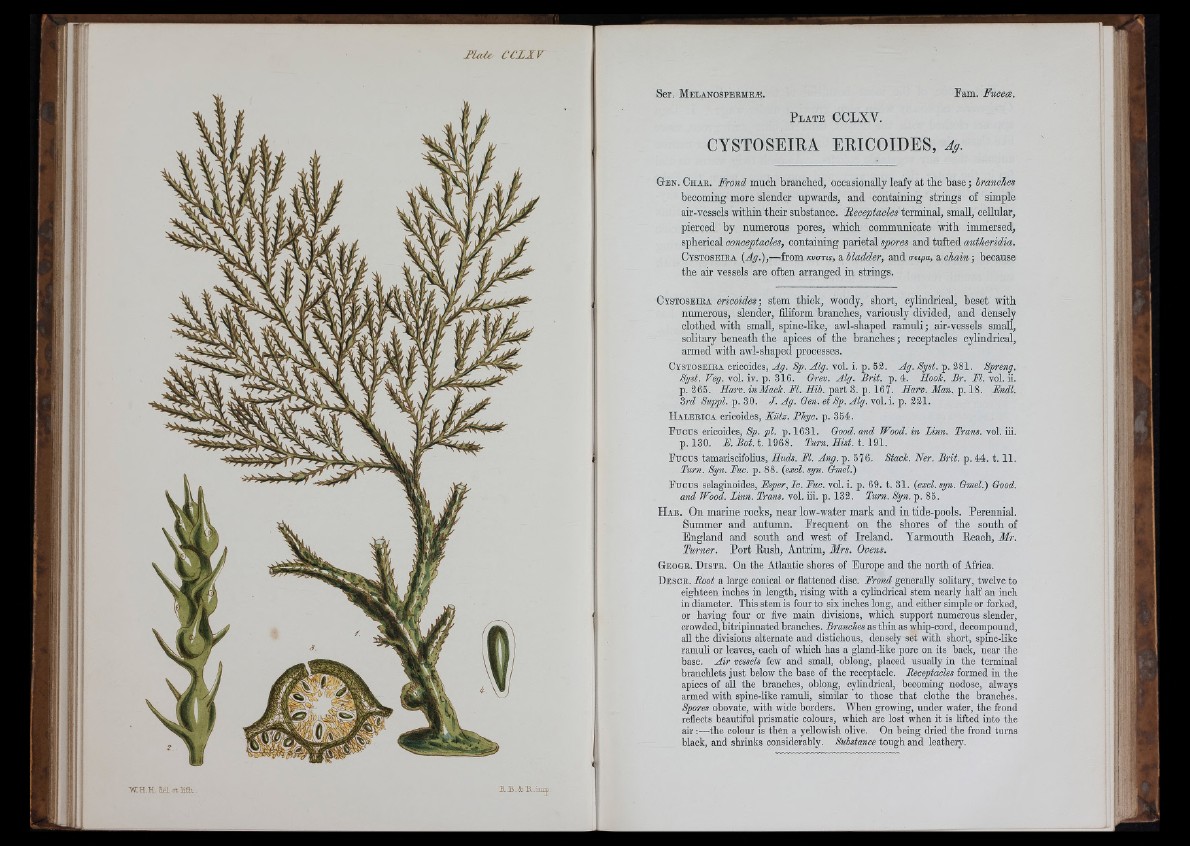
CYSTOSEIRA ERICOIDES, Ag.
Ge n . Ch a r . Frond much branched, occasionally leafy at the base ;
becoming more slender upwards, and containing strings of simple
air-vessels within their substance. Beceptacles terminal, small, cellular,
pierced by numerous pores, which communicate with immersed,
spherical conceptacles, containing parietal spores and tufted autheridia.
Cystoseira {Ag.),—from jcw™, a wiA mipa, s, chain ; because
the air vessels are often arranged in strings.
Cystoseira ericoides; stem thick, woody, short, cylindrical, beset with
numerous, slender, filiform branches, variously divided, and densely
clothed with small, spine-like, awl-shaped ramuli; air-vessels small,
solitary beneath the apices of the branches; receptacles cybndrioal,
armed with awl-shaped processes.
C y s t o s e i r a ericoides, Ag. Sp. Alg. vol. i. p. 63. Ag. Syst. p. 381. Spreng.
Syst. Veg. vol. iv. p. 316. Grev. Alg. Brit. p. 4. Hook. Br. M. vol. ii.
p. 365. Harv.inMack. M. Rib. paxiZ. p . lZ l . Harv. Man. p. IZ. Endl.
Zrd Suppl. p. 30. J. Ag. Gen. et Sp. Alg. vol. i. p. 331.
H a l e e i c a ericoides, Kiitz. Fhyc. p. 354.
F c cu s ericoides, Sp. p i. p. 1631. Good, and Wood, in Linn. Trans, vol. iii.
p. 130. E .B o t.t.l^ Z Z . Turn. Hist. t. m .
F u c c s tamariscifolius, Huds. El. Ang. p. 576. Stack. Ner. Brit. p. 44. t. 11.
Turn. Syn. Fuc. p. 88. {excl. syn. Gmel.)
Fucu s selaginoides, Esper, Ic. Fuc. vol. i. p. 69. t. 31. {excl. syn. Gmel.) Good,
ard Wood. lAnn. Trans, vol. iii. p. 133. Turn. Syn. p. 85.
H a s . On marine rocks, near low-water mark and in tide-pools. Perennial.
Summer and autumn. Frequent on the shores of the south of
England and south and west of Ireland. Yarmouth Reach, Mr.
Turner. Port Rush, Antrim, Mrs.
G e o g e . D i s t e . On the Atlantic shores of Europe and the north of Africa.
D e s c e . Boot a large conical or flattened disc. Frcmd generally solitary, twelve to
eighteen inches in length, rising with a cylindrical stem nearly half an inch
in diameter. This stem is four to six inches long, and either simple or forked,
or having four or five main divisions, which support numerous slender,
crowded, bitripinnated branches. Branches as thin as whip-cord, decompound,
all the divisions alternate and distichous, densely set with short, spine-like
ramuli or leaves, each of which has a gland-like pore on its back, near the
base. A ir vessels few and small, oblong, placed usually in the terminal
branchlets just below the base of the receptacle. Beceptacles formed in the
apices of an the branches, oblong, cylindrical, becoming nodose, always
armed with spine-like ramuli, similar to those that clothe the branches.
Spores obovate, with wide borders. When growing, under water, the frond
reflects beautiful prismatic coloui's, which are lost when it is lifted into the
air ;—the colour is then a yellowish olive. On being dried the frond turns
black, and shrinks considerably. Substance tough and leatheiy.
W H .H .Îiîle ttiÜ l. ..unp.